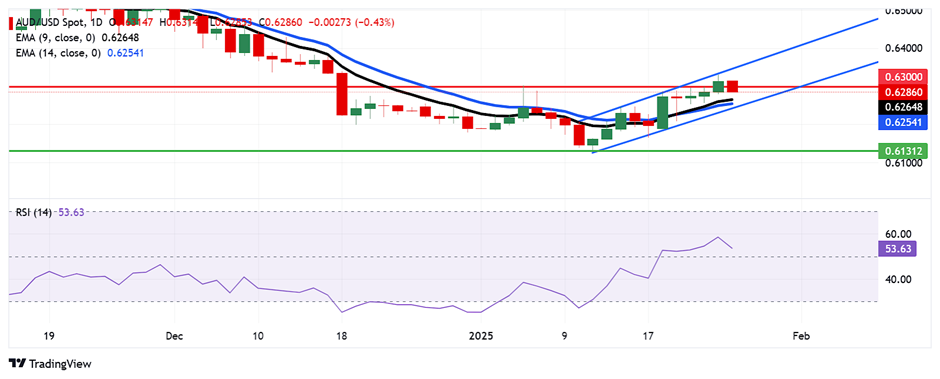- The Australian dollar maintains losses after the publication of mixed data from the Purchasing Management Index of China.
- The China Stock Regulatory Commission has approved a second round of investment pilot programs in long -term shares valued at 7.25 billion dollars.
- The USD is strengthened in the midst of uncertainty about the impact of commercial and immigration policies of the US president, Donald Trump.
The Australian dollar (AUD) ends its three -day streak against the US dollar (USD), with the aud/USD torque contributing down after the publication of mixed data of the Purchasing Manager Index (PMI) of China the Monday. As close business partners, China’s economic performance significantly impacts the Australian economy.
The manufacturing PMI of the China NBS fell to 49.1 in January, from 50.1 in December, not reaching the market expectation of 50.1. Similarly, NBS non -manufacturing PMI decreased to 50.2 in January compared to reading December 52.2.
The Australian dollar also did not obtain support from the new stimulus measures of China to promote the development of investment products in indices, its last effort to revive the weakened variable income market. The Chinese Securities Regulatory Commission (CSRC) has approved a second round of Pilot Investment Programs in long -term shares valued at 52 billion yuanes (7.25 billion dollars).
China’s industrial profits decreased by 3.3% year -on -year to 7,431.05 billion CNY in 2024, relief from the 4.7% drop recorded in the first 11 months of the year. This marks the third consecutive year of contraction, after a 2.3% decrease in 2023. Continuous recession reflects the ongoing economic challenges, including the weak demand, the increase in deflationary pressures and a prolonged drop in the real estate sector.
The Australian dollar falls due to the increase in risk aversion with respect to Trump’s policies
- The US dollar index (DXY), which tracks the value of the dollar against six main currencies, has bounced since its monthly minimum of 107.22 registered on Friday. The DXY quotes about 107.60 at the time of writing.
- The USD gains strength in the midst of uncertainty about the impact of commercial and immigration policies of the US president, Donald Trump. This context can encourage the Federal Reserve (FED) to maintain a cautious posture about the reduction of interest rates this year.
- According to Global S&P data published on Friday, the PMI composed of the US fell to 52.4 in January from 55.4 in December. The manufacturing PMI rose to 50.1 in January, exceeding the previous reading of 49.4 and exceeding the 49.6 forecast. However, the PMI of Services fell to 52.8 in January from 56.8 in December, below the expected 56.5.
- However, Trump said Thursday that he wants the FED to reduce interest rates immediately. “With oil prices going down, I will demand that interest rates go immediately, and in the same way they should be lowering around the world,” Trump said in the World Economic Forum in Davos, Switzerland.
- The US dollar faced challenges since Trump’s comments occurred before the Federal Reserve Monetary Meeting (FED) scheduled for January 28 and 29, with expectations that the US Central Bank maintain the stable rates.
- Operators expect the FED to maintain its reference rate to one day in the range of 4.25% -4.50% at its January meeting. In addition, Trump’s policies could boost inflationary pressures, potentially limiting the Fed to only one more rates cut.
- President Trump has imposed an emergency tariff of 25% to all Colombian goods entering the United States (USA), with plans to increase it to 50% within a week. The measure occurs after Colombia refused to allow two US military planes carrying deported migrants landed. A White House official, speaking with Reuters on Sunday, declared that the measure was intended to serve other nations about the consequences of rejecting deportation flights.
- The purchasing managers index (PMI) composed of the Judo Bank of Australia rose to 50.3 in January, from 50.2 in December. Meanwhile, the manufacturing PMI rose to 49.8 in January from 47.8 in December, the highest reading in 12 months, breaking a streak of 13 consecutive contraction. However, the PMI of Services fell to 50.4 from 50.8, reaching a minimum of six months and indicating a slowdown in sector growth.
- President Trump expressed optimism, stating that “he would prefer not to have to wear tariffs on China” and was hopeful about reaching an agreement. Trump’s comments occurred after his conversation with the president of China, Xi Jinping, Thursday, hinting at possible progress in commercial negotiations between the US and China.
- The Chinese authorities introduced several measures on Thursday to stabilize their stock markets, including authorization to pension funds to increase investments in national shares. A pilot scheme that will allow insurers to buy shares will be launched in the first half of 2025, with an initial scale of at least 100 billion yuan. Meanwhile, the Popular Bank of China (PBOC) said that “it will expand the scope and increase the scale of the liquidity tools to finance purchases of shares at the right time.”
Technical Analysis: The Australian dollar could test the upper limit of the ascending channel at 0.6350
The Aud/USD pair quotes about 0.6290 on Monday, showing an upward movement within an upward channel in the daily chart, which suggests a possible bullish bias. The 14 -day relative force (RSI) index remains slightly above 50, supporting the positive feeling of the market.
Upwards, the AUD/USD torque could re -test the key psychological resistance at 0.6300, with the next objective near the upper limit of the channel around 0.6350.
The initial support is found in the nine -day exponential (EMA) average of 0.6265, followed by the 14 -day EMA at 0.6254. A stronger support is located near the lower limit of the channel around 0.6240.
AUD/USD: Daily graphic
Australian dollar Price today
The lower table shows the percentage of change of the Australian dollar (AUD) compared to the main currencies today. Australian dollar was the weakest currency against the Japanese yen.
| USD | EUR | GBP | JPY | CAD | Aud | NZD | CHF | |
|---|---|---|---|---|---|---|---|---|
| USD | 0.33% | 0.29% | -0.02% | 0.21% | 0.49% | 0.47% | 0.16% | |
| EUR | -0.33% | 0.03% | -0.20% | 0.02% | 0.16% | 0.26% | -0.06% | |
| GBP | -0.29% | -0.03% | -0.54% | -0.00% | 0.13% | 0.25% | -0.09% | |
| JPY | 0.02% | 0.20% | 0.54% | 0.26% | 0.67% | 0.72% | 0.32% | |
| CAD | -0.21% | -0.02% | 0.00% | -0.26% | 0.07% | 0.26% | -0.08% | |
| Aud | -0.49% | -0.16% | -0.13% | -0.67% | -0.07% | 0.14% | -0.18% | |
| NZD | -0.47% | -0.26% | -0.25% | -0.72% | -0.26% | -0.14% | -0.55% | |
| CHF | -0.16% | 0.06% | 0.09% | -0.32% | 0.08% | 0.18% | 0.55% |
The heat map shows the percentage changes of the main currencies. The base currency is selected from the left column, while the contribution currency is selected in the upper row. For example, if you choose the Australian dollar of the left column and move along the horizontal line to the US dollar, the percentage change shown in the box will represent the Aud (base)/USD (quotation).
Faqs Australian dollar
One of the most important factors for the Australian dollar (Aud) is the level of interest rates set by the Australian Reserve Bank (RBA). Since Australia is a country rich in resources, another key factor is the price of its greatest export, iron mineral. The health of the Chinese economy, its largest trading partner, is a factor, as well as inflation in Australia, its growth rate and commercial balance. The feeling of the market, that is, if investors are committed to more risky assets (Risk-on) or seek safe shelters (Risk-Off), it is also a factor, being the positive risk-on for the AUD.
The Australian Reserve Bank (RBA) influences the Australian dollar (AUD) by setting the level of interest rates that Australian banks can lend to each other. This influences the level of the interest rates of the economy as a whole. The main objective of the RBA is to maintain a stable inflation rate of 2% -3% by adjusting the interest rates or the low. Relatively high interest rates compared to other large central banks support the AU, and the opposite for the relatively low. The RBA can also use relaxation and quantitative hardening to influence credit conditions, being the first refusal for the AU and the second positive for the AUD.
China is Australia’s largest commercial partner, so the health of the Chinese economy greatly influences the value of the Australian dollar (Aud). When the Chinese economy goes well, it buys more raw materials, goods and services in Australia, which increases the demand of the AU and makes its value upload. The opposite occurs when the Chinese economy does not grow as fast as expected. Therefore, positive or negative surprises in Chinese growth data usually have a direct impact on the Australian dollar.
Iron mineral is the largest export in Australia, with 118,000 million dollars a year according to data from 2021, China being its main destination. The price of iron ore, therefore, can be a driver of the Australian dollar. Usually, if the price of iron ore rises, the Aud also does, since the aggregate demand of the currency increases. The opposite occurs when the price of low iron ore. The highest prices of the iron mineral also tend to lead to a greater probability of a positive commercial balance for Australia, which is also positive for the AUD.
The commercial balance, which is the difference between what a country earns with its exports and what it pays for its imports, is another factor that can influence the value of the Australian dollar. If Australia produces highly requested exports, its currency will gain value exclusively for the excess demand created by foreign buyers who wish to acquire their exports to what you spend on buying imports. Therefore, a positive net trade balance strengthens the AUD, with the opposite effect if the commercial balance is negative.
Source: Fx Street
I am Joshua Winder, a senior-level journalist and editor at World Stock Market. I specialize in covering news related to the stock market and economic trends. With more than 8 years of experience in this field, I have become an expert in financial reporting.








